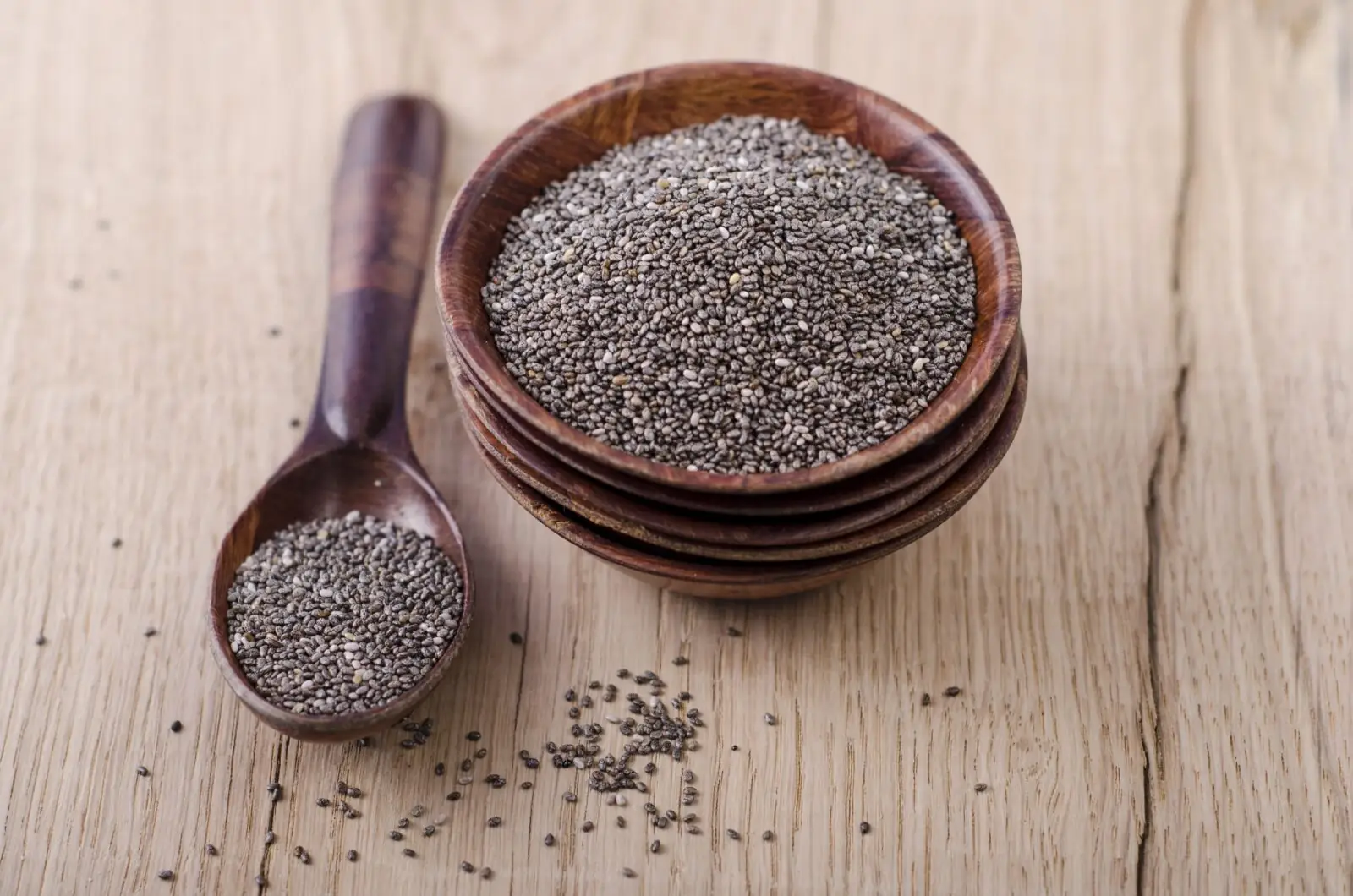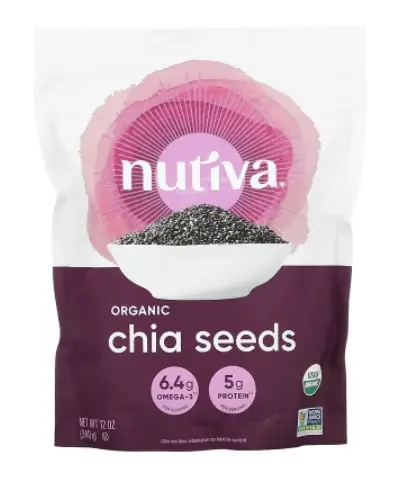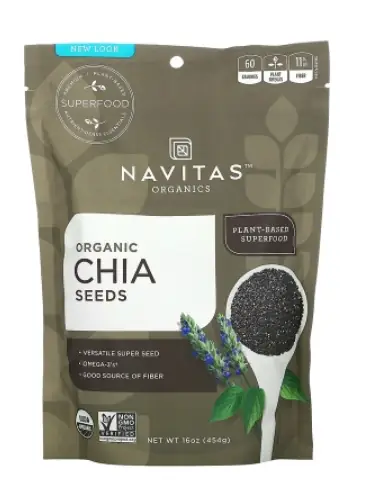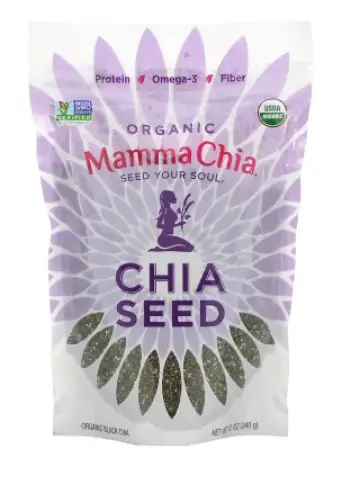Chia: Seeds That Are Full of Good Vitamins and Minerals

Chia seeds remain all the rage for nearly three decades. What are the real health benefits of chia seeds? Are they as good for you as manufacturers claim? Let’s take a close look at this Latin American food.
Chia Seeds: High Nutrition Value, a Lot of Dietary Minerals and B Vitamins
Chia is very nutritious: dried seeds contain as many as 486 kcal as well as 16% protein, 31% fat, and 42% carbohydrates. It is a very good source of such B vitamins as thiamin (vitamin B1) and niacin (vitamin B3), and such minerals as calcium, iron, magnesium, manganese, phosphorus, and zinc. The crop also contains moderate quantities of riboflavin (vitamin B2) and folate (vitamin B9) and potassium.
It is little wonder that the Aztecs cultivated chia as a staple food and considered it as important as corn and beans; sometimes it was even used instead of money. The word ‘chia’ is said to mean ‘strength’ in the language of the Maya peoples. Runners (messengers) and warriors who needed a lot of calories used this crop as energy-packed food when away from home.
Still, contrary to popular belief, this food is a poor source of vitamins C and E, and contains no or almost no vitamins A, B5, and B12. It has some of the vitamins you need daily but not all of them.
Precursor of Omega-3 Fatty Acids
The fat content of the crop is divided between polyunsaturated omega-6 linoleic acid (about 20% of total fat) which is known to lower the risk of cardiovascular disease and linolenic acid (nearly 60%).
In its turn, linolenic acid in the crop is a mixture of both α- and γ-Linolenic acid. α-Linolenic acid (shortened to ALA) is a precursor to two important omega-3 fatty acids, namely eicosapentaenoic acid (APA) and docosahexaenoic acid (DHA). Both APA and DHA are extremely important for cardiovascular health, the nervous system (including the brain), and retina function, as well as women’s health during pregnancy and nursing.
Still, it should be mentioned that varying from individual to individual, the rate of transforming ALA into APA/DHA can be significantly higher or lower. In fact, because of their genetic defects some people cannot benefit from ALA at all as their bodies convert it into very small amounts of omega-3 fatty acids.
Thus, regardless of the theoretical chia seeds benefits in pregnancy, it is strongly recommended that pregnant women use high-quality fish oil as well. Fish oil is the best possible source of APA and DHA: it contains the acids themselves and there is no need for any conversion.
Chia Seeds: Benefits for Weight Loss
As many as 80% of carbohydrates in the crop are dietary fiber. Dietary fiber cannot be broken down by the human digestive tract; in fact, it is a filler that makes you feel full while not giving you any calories, which is ideal for weight loss.
What’s more, the crop contains large quantities of protein which are known to help in losing weight. Protein is not as calorie-packed as carbohydrates and fat; it serves as a building material for the body and effectively curbs hunger for a long time.
There are also findings that this food might reduce the levels of a hormone called ghrelin which is known for stimulating hunger.
Still, effective weight loss is hardly possible without regular exercising: use chia as an addition and not as a substitute for working out at the gym, walking, swimming, or jogging.
Digestive Health
Great quantities of dietary fiber prevent constipation and promote regular stool. Among other things constipation leads to listlessness and bad mood; chia relieves these symptoms and helps you feel optimistic and full of energy.
While your digestive system cannot break down dietary fiber, the beneficial microorganisms that live in your gut can, and a healthy microbiome is extremely important for your body’s immunity to infection and general health.
Might Be Good for Blood Pressure and Sugar Level
There is a 2021 study that found that the combination of fatty acids, dietary fiber, and high-quality protein found in chia can help normalize systolic blood pressure. Another 2018 study shows that this food can also help people with type 2 diabetes to maintain normal blood sugar levels. Although none of the studies is conclusive, people with diabetes might benefit from including these seeds in their daily diet.
Exercise Performance
It is recommended that athletes consume protein as a post-workout meal to repair their damaged muscle tissues and build new ones. Chia is one of the best sources of protein among numerous other seeds and grains, so using it as a part of a post-workout meal will help you more quickly increase your muscle mass. Still, do not rely solely on this crop: use other protein sources (like meat) as well.
Benefits for Bone Health
Your body uses calcium to maintain the strength and density of the bones; another dietary mineral, manganese, is involved in bone formation and metabolism. An ounce of the seeds (28 grams or 2.8 tablespoons) contains 18% of the recommended daily calcium intake and as many as 30% of the required daily intake of manganese. What’s more, because of their high calcium content, the seeds also promote dental health.
Chia Seeds: Benefits for Skin and Hair
While the crop might not be the best possible food for having smooth skin and glossy hair, it still offers important benefits for their health:
- It contains antioxidants like caffeic acid, chlorogenic acid, kaempferol, and quercetin that prevent oxidative stress, which is very important for tissue repair and fighting premature aging;
- It promotes general health, and the healthier you are, the better your skin and hair look;
- What’s more, you can apply chia oil to the skin to hydrate it with essential fatty acids.
Cancer: No Conclusive Evidence
While it is sometimes stated that because of their combination of antioxidants and alpha-linolenic acid the seeds can limit the growth of cancer cells, there is no conclusive medical evidence for this claim. No major scientific studies were carried out in this respect.
Chia Seeds: Benefits and Side Effects
The crop is one of those foods which offer a winning combination of numerous benefits for the health and hardly any negative side effects if consumed in moderation. Still, if you eat a lot of this crop daily, you might experience one of these issues:
- Stomach discomfort (including meteorism) due to high dietary fiber content;
- Weight gain: if you consume a lot of seeds daily, high-fat content will overcome the benefits of dietary fiber and protein.
How much chia seeds should I eat a day? Two to three tablespoons daily with a lot of water will be enough: moderation in all things, as they say.
There have been found neither adverse effects nor interactions of the crop with prescription drugs.
Chia Seeds: Healthy Recipes
You don’t necessarily have to grind the seeds, boil them or prepare them using the heat in some other way. They can be eaten whole and raw as well as used in numerous other ways like:
- sprinkled on top of yogurt;
- used as a decoration with raw and boiled vegetables;
- added to cereal and rice dishes;
- added to pudding, oatmeal, and baked goods.
What’s more, as they readily absorb fat and water, you can use chia to thicken your sauces and instead of an egg when cooking fritters. Here is the proportion: soak 15 grams (1 tablespoon) of seeds in 45 milliliters (3 tablespoons) of water.
To use chia instead of an egg for your meatballs, add 30 grams (2 tablespoons) of seeds to 450 grams (one pound) of meat.
Chia Water — and More
One of the easiest possible ways to enjoy the crop is to prepare water with chia seeds. The benefits of such a beverage are easy to see: you can make it in less than a minute, cool it down in the refrigerator, and drink small portions during the day. Absolutely no cooking skills are required.
Here is the recipe: you add 1 liter (slightly more than 1 US quart) of water to 40 grams (¼ cup) of seeds and add some chopped fruit or a bit of lemon or orange juice. Leave the beverage for half an hour for seeds to soak thoroughly — and drink it with pleasure.
If you like tea, brew some and use it instead of water: cold tea with chia makes an excellent beverage in the summer heat.
Water or tea can be substituted with fruit juice: the proportion remains the same. On the bright side, this version of the beverage tastes much sweeter; on the dark side, it contains a lot of sugar, which is not what you need if you use chia for weight loss.
If you opt for milk instead of fruit juice, you will get one more version of the same recipe that can be used instead of morning cereal. To prepare it, use the same proportion and let the seeds soak in milk during the night (you can also use milk substitutes like soy or almond milk). In the morning add some nuts and pieces of fruit. You might also use vanilla extract, mashed banana, and/or spices like cinnamon for additional flavor. A truly great way to meet a new day!
All Varieties Are Equally Good
Scientifically speaking, the commercial name ‘chia seeds’ is applied to not one but two plants: Salvia hispanica and its close relative Salvia columbariae (also called ‘golden’ and ‘desert’ chia).
- The seeds of S. hispanica are oval; about 2 mm (0.08 in) long and 1 mm (0.04 in) wide. They can have a variety of colors: white, black, gray, and brown.
- The seeds of S. columbariae are also oval and have the same dimensions. Their color is either tan or gray.
Despite differences in coloring, S. hispanica and S. columbariae have benefits for the health that are absolutely the same. Thus, there is no need to overpay for the super-healthy ‘white/brown/black’ variety.
The growing popularity of the crop led to a considerable expansion of its cultivation area. It is grown in numerous Latin American countries such as Argentina, Bolivia, Equator, Guatemala, Mexico, and Nicaragua. What’s more, chia managed to cross the Pacific (some farmers grow it as far west as Australia) and the US border (among other territories, S. columbariae variety is produced in Arizona, California, Nevada, New Mexico, and Utah).
Where to Buy
When buying, opt for organic products with the expiration date as far in the future as possible. While some people prefer chia from Mexico and Guatemala (the countries from which the crop originally comes from), there is absolutely no evidence that crops from Argentina, Bolivia and other countries are less beneficial for the health.
iHerb has a very wide choice of these Latin American seeds; the store is known for its affordable prices, customer-oriented sales policy, and money-saving discount program. These two offers are especially worth considering:

- High buyer rating (4.6 stars)
- Certified organic
- Affordable price
- Country of origin: Paraguay
Navitas Organics, Organic Chia Seeds

- Trusted and popular brand
- High buyer rating (4.7 stars)
- Certified organic
- Reasonable price

- Very high buyer rating (4.8 stars)
- Certified organic & woman owned
- One of the most popular brands on iHerb.com
After you have opened the bag, put the seeds in a container with a tight-fitting lid (either glass or plastic). If stored like this in the refrigerator, they will remain fresh for up to three years; if you plan to use them within months, any dark, cool place — like a cupboard — will do.
Why Chia Seeds Are Good for You: an Overview
This Latin-American crop:
- contains 486 kcal per 100 grams or about 136 kcal per ounce;
- has large quantities of some B vitamins (B1, B3) and dietary minerals (calcium, iron, magnesium, manganese, phosphorous, zinc);
- contains ALA — a precursor to important omega-3 fatty acids APA and DHA;
- has a lot of dietary fiber that prevents constipation and has a lot of benefits for microbiome and gut health;
- might help you (in combination with exercising and a healthy diet) to lose weight;
- is beneficial for bones and teeth;
- can be used by athletes for increasing their muscle mass (in combination with other protein sources);
- is good for skin and hair;
- might help to improve blood pressure and sugar level;
- has no adverse effects on health if consumed moderately (up to 3 tablespoons per day);
- does not interact with prescription drugs;
- can be added to all kinds of foods or used to prepare very special water/tea/milk/fruit juice beverages;
- offers the same health benefits regardless of color and botanic variety;
- can be easily bought on iHerb.
Now you know what are the health benefits of chia seeds. Add them to your meals, stay healthy and enjoy your life!